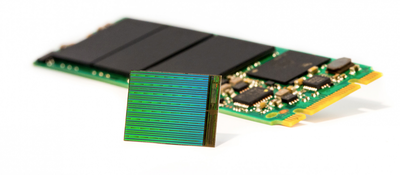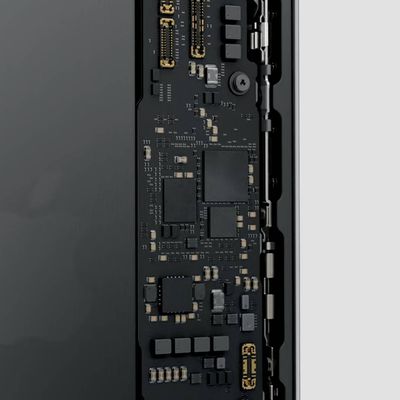Intel's New 3D NAND Technology Allows for Greater Than 10TB Solid-State Drives
Intel and Micron on Thursday announced the availability of new 3D NAND technology that enables high-density flash devices with three times more storage capacity than other NAND technologies in production. 3D NAND technology is also more cost efficient than planar NAND, with faster performance, improved latency and new sleep modes that result in low-power use by cutting power to inactive NAND die.

The advancements pave the way for future Macs and other devices with flash memory to be equipped with greater than 10TB solid-state drives, significantly more storage capacity than the maxed out 1TB PCIe-based flash storage upgrade option that Apple offers for the MacBook Pro, iMac and Mac Pro. As planar NAND faces practical scaling limits, Intel and Micron expect that 3D NAND will shape the future of flash memory.
"Micron and Intel's collaboration has created an industry-leading solid-state storage technology that offers high density, performance and efficiency and is unmatched by any flash today," said Brian Shirley, vice president of Memory Technology and Solutions at Micron Technology. "This 3D NAND technology has the potential to create fundamental market shifts. The depth of the impact that flash has had to date—from smartphones to flash-optimized supercomputing—is really just scratching the surface of what's possible."
3D NAND has innovative process architecture with a floating gate cell that enables greater performance and increased quality and reliability. Intel and Micron expect that 3D NAND technology, which "stacks flash cells vertically in 32 layers to achieve 256Gb multilevel cell (MLC) and 384Gb triple-level cell (TLC) die," will result in continued performance gains, cost savings and widespread adoption of flash storage solutions for mobile consumer devices and enterprise deployment.
Intel and Micron claim that the 256Gb MLC version of 3D NAND is being sampled by select partners beginning this week, while the 384Gb TLC design will be sampling later this spring. Both devices are slated to enter full production in the fourth quarter, and both companies are developing separate lines of SSD solutions based on 3D NAND technology that are expected to be available within the next year.
Given that flash storage solutions using 3D NAND are not expected to be available until the end of this year at the earliest, it is unlikely that larger SSDs based on the new technology will be included in any next-generation Macs for the foreseeable future. Apple also recently refreshed the MacBook Air and 13-inch MacBook Pro, so those two notebook models in particular are still early in their product cycles.
Popular Stories
Apple hasn't updated the Apple TV 4K since 2022, and 2025 was supposed to be the year that we got a refresh. There were rumors suggesting Apple would release the new Apple TV before the end of 2025, but it looks like that's not going to happen now.
Subscribe to the MacRumors YouTube channel for more videos.
Bloomberg's Mark Gurman said several times across 2024 and 2025 that Apple would...
You'd think things would be slowing down heading into the holidays, but this week saw a whirlwind of Apple leaks and rumors while Apple started its next cycle of betas following last week's release of iOS 26.2 and related updates.
This week also saw the release of a new Apple Music integration with ChatGPT, so read on below for all the details on this week's biggest stories!
Top Stories
i...
The European Commission today praised the interoperability changes that Apple is introducing in iOS 26.3, once again crediting the Digital Markets Act (DMA) with bringing "new opportunities" to European users and developers.
The Digital Markets Act requires Apple to provide third-party accessories with the same capabilities and access to device features that Apple's own products get. In iOS...
Earlier this month, Apple released iOS 26.2, following more than a month of beta testing. It is a big update, with many new features and changes for iPhones.
iOS 26.2 adds a Liquid Glass slider for the Lock Screen's clock, offline lyrics in Apple Music, and more. Below, we have highlighted a total of eight new features.
Liquid Glass Slider on Lock Screen
A new slider in the Lock...
Next year's iPhone 18 Pro and iPhone 18 Pro Max will be equipped with under-screen Face ID, and the front camera will be moved to the top-left corner of the screen, according to a new report from The Information's Wayne Ma and Qianer Liu.
As a result of these changes, the report said the iPhone 18 Pro models will not have a pill-shaped Dynamic Island cutout at the top of the screen....
While the iPhone 18 Pro and iPhone 18 Pro Max are not expected to launch for another nine months, there are already plenty of rumors about the devices.
Below, we have recapped 12 features rumored for the iPhone 18 Pro models.
The same overall design is expected, with 6.3-inch and 6.9-inch display sizes, and a "plateau" housing three rear cameras
Under-screen Face ID
Front camera in...
Apple is significantly increasing its reliance on Samsung for iPhone memory as component prices surge, according to The Korea Economic Daily.
Apple is said to be expanding the share of iPhone memory it sources from Samsung due to rapidly rising memory prices. The shift is expected to result in Samsung supplying roughly 60% to 70% of the low-power DRAM used in the iPhone 17, compared with a...
Apple's first foldable iPhone, rumored for release next year, may turn out to be smaller than most people imagine, if a recent report is anything to go by. According to The Information, the outer display on the book-style device will measure just 5.3 inches – that's smaller than the 5.4-inch screen on the iPhone mini, a line Apple discontinued in 2022 due to poor sales. The report has led ...























